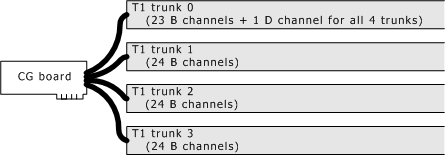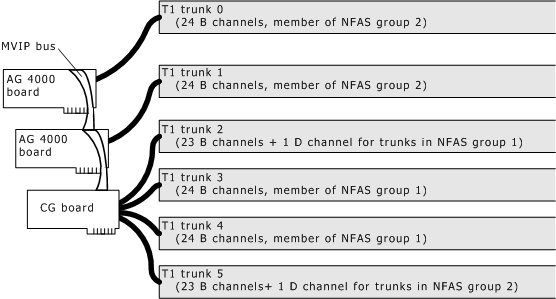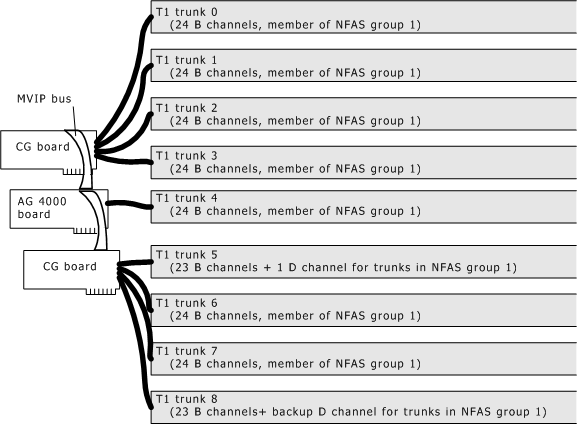
In systems with multiple T1 ISDN trunks, a non-facility associated signaling (NFAS) configuration can be used. This topic describes:
Data on a T1 trunk is transmitted in channels. For primary rate ISDN, T1 carries 24 channels. With primary-rate ISDN:
23 of the 24 channels carry voice, audio, data, and video signals. These channels are called bearer channels (B channels).
On a T1 trunk, one channel carries signaling for all B channels. This is called the D channel. On T1 trunks, the D channel is typically carried in channel 24. See the following illustration:

In an NFAS configuration, trunks are grouped into one or more NFAS groups. One of the trunks in each group has a D channel carrying the signaling for all of the B channels on all of the trunks in the group, up to 20 trunks per group. This leaves channel 24 free on all other trunks in the NFAS group. This extra channel can be used as another B channel, as shown in the following illustration:

A single NFAS group can contain trunks from multiple boards, as shown in the following illustration:

If your application uses NMS ISDN software in a channelized configuration, all trunks in an NFAS group must be on the same board. An NFAS group cannot contain trunks from multiple boards. This restriction does not apply to the ACU or LAPD configurations.
If an NFAS group spans multiple boards in a Hot Swap system and you remove or insert a board while the system is running, the NMS ISDN protocol stacks on the other boards are not affected. If you remove a board containing only B channels, the stack on the D channel board does not sense that the board is missing. It is the application's responsibility to sense this change and take appropriate action (to not access B channels on that board).
To group T1 trunks into NFAS groups, your board keyword file must contain information regarding the NFAS-specific tasks the trunks will perform. To accomplish this, add the keywords described in this topic to your board keyword file for the trunk that carries the primary D channel.
When you set up NFAS groups, make sure to correctly set the NetworkInterface.T1E1[x].SignalingType keyword for each trunk, as described in Configuring data routing.
Note: These keywords are required only if you are setting up NFAS groups.
This keyword specifies the NFAS group number, as follows:
NetworkInterface.T1E1[x].ISDN.NFAS_Group= group_no
where x is the trunk that carries the primary D channel and group_no is the NFAS group number. There is a maximum of 16 groups.
This keyword must be accompanied by one or more groups of NetworkInterface.T1E1[x].ISDN.NFAS_Member[y].Board and NetworkInterface.T1E1[x].ISDN.NFAS_Member[y].Trunk statements to specify the board and trunk numbers for each member of this NFAS group.
This keyword specifies the trunk that carries the primary D channel, as follows:
NetworkInterface.T1E1[x].D_Channel= ISDN
where x is the trunk that carries the primary D channel. In each NFAS group, only one trunk (x) can carry the D channel, unless D channel backup is used. Refer to D channel backup.
If this keyword is set to ISDN for a trunk, the NetworkInterface.T1E1[x].SignalingType keyword (described in Configuring data routing) must be set to PRI or BRI for that trunk. If a trunk is part of an NFAS group but does not carry a D channel, NetworkInterface.T1E1[x].SignalingType must be set to RAW for that trunk. Specify the backup D channel using the keyword NetworkInterface.T1E1[x].ISDN.D_Channel_Backup_Trunk, where x is the trunk that carries the primary D channel.
This keyword specifies the board number of a member trunk of an NFAS group.
Specify one of these statements for every NFAS member (y) on every trunk (x) that carries a primary D channel. This field must be set in the board keyword file for the board where the D channel resides. The board number must match the board number specified in the OAM system configuration file, oamsys.cfg.
This keyword identifies the network access identifier (NAI) of a member trunk of an NFAS group, as follows:
NetworkInterface.T1E1[2].ISDN.NFAS_Member[1].NAI= nai
where nai is the NAI of the trunk and ranges from 0 to 127. The NAI of each trunk in an NFAS group must be unique.
Specify one of these statements for every NFAS member (y) on every trunk (x) that carries a primary D channel. This field must be set in the board keyword file for the board where the D channel resides.
This keyword specifies the trunk number of a member trunk of an NFAS group.
Specify one of these statements for every NFAS member (y) on every trunk (x) that carries a primary D channel. This field must be set in the board keyword file for the board where the D channel resides.
When NFAS is used, the reliability of the signaling performance for the ISDN interfaces controlled by the D channel can be improved by creating a standby D channel, the D channel backup. The D channel backup feature transfers most of the signaling information to the backup D channel, enabling continued access to the ISDN network if the primary D channel fails.
The backup D channel must exist on a different trunk than the primary D channel, as shown in the following illustration:

At any point in time, only one D channel conveys B channel signaling information. The other D channel remains in a standby mode and is only active at the LAPD layer (layer 2). While the backup D channel is on standby, any layer 3 messages received on it are ignored.
Neither D channel can serve as a B channel while designated as a backup D channel. Each primary/backup D channel pair provides signaling only for the set of B channels within a specific NFAS group and cannot backup any other D channels in a different group.
When both D channels are out of service, the first D channel has priority as the channel to carry call control signaling. If the first D channel cannot be established, the backup D channel is chosen.
To configure D channel backup, edit the board keyword file as described in Configuring data routing. Then set the keywords as follows:
|
For trunk(s) with... |
Set NetworkInterface.T1E1[x].D_CHANNEL to... |
Set NetworkInterface.T1E1[x].SignalingType to... |
|---|---|---|
|
Primary D channel |
ISDN |
PRI or BRI |
|
Backup D channel |
ISDN_NONE |
PRI or BRI |
|
Only B channels |
ISDN_NONE |
RAW |
Both primary and backup D channels must be defined on the same board and belong to the same NFAS group. Set NetworkInterface.T1E1[x].ISDN.SignalingType to PRI (or BRI, where applicable) for both D channels.
Set the NetworkInterface.T1E1[x].ISDN.D_Channel_Backup_Trunk keyword to enable D channel backup. For example:
NetworkInterface.T1E1[x].ISDN.D_Channel_Backup_Trunk = trunkno
where trunkno is the number of the trunk to perform D channel backup.
When you start ISDN with Natural Access, you must enable option t309 in the ISDN_PROTOCOL_PARMS_Q931CC or ISDN_PROTOCOL_PARMS_CHANNELIZED structure, which appears as follows:
WORD t309; /* T309 in use flag */
To enable this option, set this parameter to 1 in your application. When enabled, active calls are preserved while switching to the backup D channel when the primary D channel fails. For more information on this feature, refer to the NMS ISDN Messaging API Developer's Reference Manual.